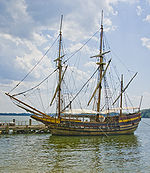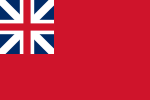The Province of Maryland was an English and later British colony in North America from 1634 until 1776, when it made common cause with the group of Thirteen Colonies in rebellion against Great Britain and, finally in 1781—as the 13th signatory to the Articles of Confederation—it ratified its perpetual union with that group as the state of Maryland. The province's first settlement and capital was St. Mary's City, located at the southern end of St. Mary's County, a peninsula in the Chesapeake Bay that is bordered by four tidal rivers.
The province began in 1632 as a proprietary colony granted to Cecil Calvert, the English 2nd Baron Baltimore, whose father, George, had long sought to found a colony in the New World to serve as a refuge for English Roman Catholics at the time of the European wars of religion. Thus, provincial Maryland served an early pioneer of religious toleration in the English colonies. However, religious strife among Anglicans, Puritans, Catholics, and Quakers was common in the early years and Puritan rebels briefly seized control of the province. Later, in 1689, the year following the Glorious Revolution in Great Britain, John Coode led a rebellion that removed Lord Baltimore, a Catholic, from power in Maryland. That power was restored to the Baltimore family in 1715 after Charles Calvert, 5th Baron Baltimore, declared in public that he was a Protestant.
Despite early competition with the colony of Virginia to its south, and the Dutch colony of New Netherland to its north, the province of Maryland developed along similar lines to Virginia. Its early settlements and population centers tended to cluster around the rivers and other waterways that empty into the Chesapeake Bay, and, like Virginia, Maryland's economy quickly became centered on the cultivation of tobacco for sale in Europe.
However, after tobacco prices collapsed, the need for cheap labor to accommodate the mixed farming economy that followed led to a rapid expansion of the Atlantic slave trade and the concomitant American enslavement of Africans—as well as the expansion of indentured servitude and British penal transportation. Maryland received a larger felon quota than any other province.Maryland was an active participant in the events leading up to the American Revolution, echoing events in New England by establishing committees of correspondence and hosting its own tea party similar to the one that took place in Boston. By 1776 the old order had been overthrown as Maryland's colonial representatives signed the Declaration of Independence, presaging the end of British colonial rule.










